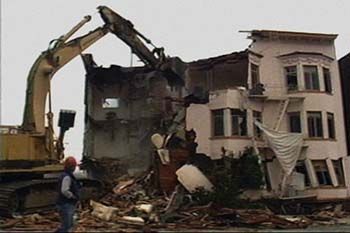Film Scratches focuses on the world of experimental and avant-garde film, especially as practiced by individual artists. It features a mixture of reviews, interviews, and essays.
A Review by David Finkelstein.
Dolissa Medina’s beautiful 30-minute short The Crow Furnace is a film prose poem that blends archival footage, surreal narrative, and montage into a powerful meditation on the history of San Francisco, with its repeated cycles of fires, earthquakes, and hopeful rebuilding. In the film’s prolog, we see archival footage of San Francisco in 1906, largely destroyed by an earthquake and ensuing fire. Medina immediately frames this event by focussing on the story of one particular man whose body is burnt beyond recognition, yet somehow his identifying business card survives. Sensitively mixing the archival footage with reenacted scenes, guitar music, and sound effects, this prolog sets the poetic, elegiac tone for the film.
 One strand woven into the film’s texture is a surreal and poetic story of two characters, the Fireman (Victor Repizo) and the Singer (Alexandra Creighton). These two figures, who are bound together for mysterious reasons, are both engulfed in inner worlds which keep them from perceiving the real world around them. The Fireman thinks he is in a forest which has grown up around the ruined city, whereas the Singer thinks she is in an idealized, less built up version of the city which she remembers from years past. They come together to try and make sense of the repeated disasters which have decimated the city, even as they sense that “the big one” is about to hit in a matter of days.
One strand woven into the film’s texture is a surreal and poetic story of two characters, the Fireman (Victor Repizo) and the Singer (Alexandra Creighton). These two figures, who are bound together for mysterious reasons, are both engulfed in inner worlds which keep them from perceiving the real world around them. The Fireman thinks he is in a forest which has grown up around the ruined city, whereas the Singer thinks she is in an idealized, less built up version of the city which she remembers from years past. They come together to try and make sense of the repeated disasters which have decimated the city, even as they sense that “the big one” is about to hit in a matter of days.
Medina’s extensive use of archival footage in the film’s montage sequences is poetic and musical. News footage of houses damaged in the 1989 earthquake, or newsreels showing extravagant displays of lights in the 1915 Panama Exposition, are used repeatedly to develop the image of fire and light as a metaphor for the many transformational crises in the city’s history. The film’s striking visual leitmotifs include a repeated shot of the Fireman jumping to safety in a practice drill, evoking his permanent sense of emergency, and an image, almost an inverse signifier, of a sleek glass elevator rising in the glittering lobby of the Hyatt Regency Hotel, a sign of the city’s never-ending quest to reinvent itself. (The Hyatt lobby is familiar from the film The Towering Inferno [1974], a connection which is made explicit later in the film, making it into a doubly rich reference point.) Medina’s use of montage creates a form of visual music, invoking a local history of catastrophe. She has a distinct and powerful cinematic voice, deftly combining disparate materials with a sure sense of rhythm and an innate feeling for the poetic resonances of images. The film is filled with continually inventive, poignant developments of the visual themes.
 “All skylines frame spectacles of loss.” This line of spoken narration is typical of the densely rich, poetic language Medina uses to explore the emotional impact of continual change on the city’s inhabitants. The central metaphor of the film is the spontaneous combustion of a murder of crows in the sky, in response to the earthquake. Scavenger birds symbolize death, and this troubling image haunts the film’s protagonists.
“All skylines frame spectacles of loss.” This line of spoken narration is typical of the densely rich, poetic language Medina uses to explore the emotional impact of continual change on the city’s inhabitants. The central metaphor of the film is the spontaneous combustion of a murder of crows in the sky, in response to the earthquake. Scavenger birds symbolize death, and this troubling image haunts the film’s protagonists.
The Crow Furnace strongly hints that the wealthy new growth of the city can create loss as devastating as any fire. But the San Francisco of the hippy communes in Haight-Ashbury or the gay mecca of the Castro, the city where Americans flocked to create fantastic alternate realities which stood against the mainstream, the San Francisco which has now been obliterated by a flood of wealth, is not represented here. The Crow Furnace narrows its focus to the cycle of boom and bust, building and destruction, which is so emblematic of our national history, and it gains in poetic intensity from this tightened structure.
Medina worked for over 10 years on this short, and it shows, both in the artistic refinement of the montage and in the deep, multi-layered resonance of the words and images. The happy result of her prolonged work on the project is a condensed form in which each new moment brings rich associations, leading the viewer into a new appreciation of both the terror and the beauty of living in a place which continually rises from the ashes of its own reckless energy.
David Finkelstein is a filmmaker, musician, and critic. For more information on Film Scratches, or to submit an experimental film for review, contact lakeivan@earthlink.net.

